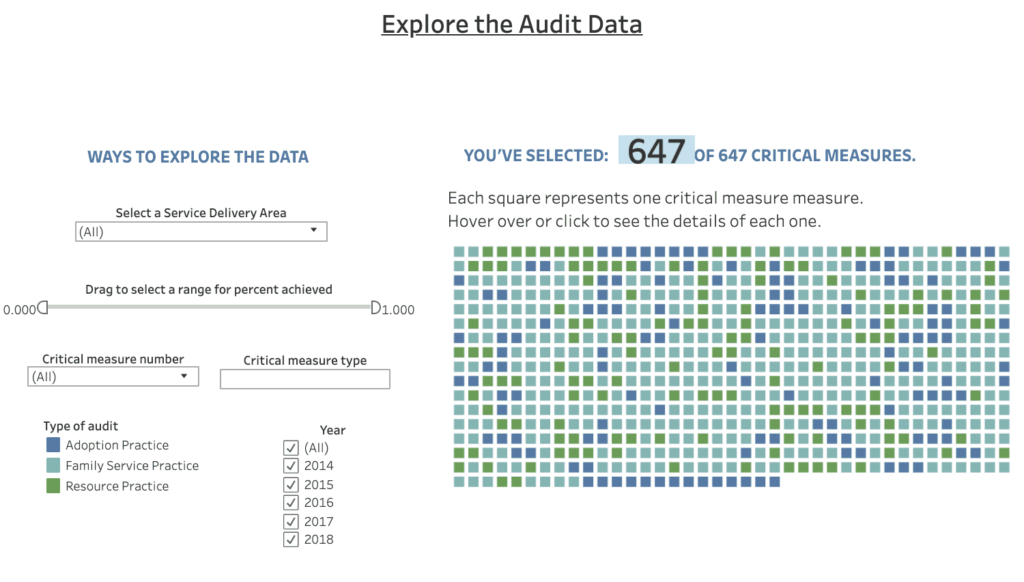
As part of the Spotlight: Child Welfare collaborative journalism project, The Discourse pulled data from 37 audits which measured the performance of social worker teams across B.C. from 2014 to 2018.
We published our findings in an investigation that showed the Ministry of Children and Family Development is routinely failing to meet basic requirements for kids in its care.
MCFD is the de facto parent for nearly 6,500 kids in foster care in B.C., but if its audits are any indication, the safety and well-being of these kids is in jeopardy.
We want to share the data we compiled with the public, so you can dig in and tell us what you think. Read below to learn more about the data and how to explore it.
If you’re a journalist, we hope you can use the data to find stories in your community. Share your stories using the hashtag #SpotlightChildWelfare.
If you have questions or want to access the raw data email francesca@thediscourse.ca.
Methodology
- We extracted the data from 37 MCFD audits, for the years 2014-2018. Those audits available online in .pdfs here.
- We extracted the data from those audits and input them into a database. Each entry includes an instance when a critical measure was given a score. We also included the service delivery area, year and type of audit conducted. We excluded nulls. That gave us 647 rows of data.
- We then created a visualization using Tableau to help us explore the data.
How to explore the data
You can access our data visualization tool online here. It’s best viewed on a desktop computer.
What you’re looking at
Each square on the right represents a score given for a critical measure or task a social worker is required to complete.
The critical measures are colour-coded to correspond to the type of audit: blue for adoption practice, teal for family service practice, green for resource practice.
You can hover over a square to see detailed information about it.

How you can filter the data
On the left you’ll find tools to narrow the field of data that you’re interested in.
As you make adjustments on the left, the boxes on the right will change accordingly, and the ticker at the top (“You’ve selected: XXX of 647 critical measures”) will tell you exactly how many critical measures are displayed in the current view.
You can filter the view by:
Service Delivery Area
These are the geographic boundaries that determine how service is delivered for MCFD. A full list of MCFD’s service delivery areas and their boundaries is available here. Select a an area from the drop-down menu to view only critical measures for that area.
Percentage that a critical measure achieved
This is the score out of 100% given by the auditor. Adjust the upper or lower limit on the slider (click and drag) to limit the range of compliance rates you want to view. To only view critical measures that received compliance rates of 100%, drag both sliders to 100 on the far right. To only view critical measures that received compliance rates of 0%, drag both sliders to 0 on the far left. To only view critical measures that received compliance rates of 50% or less, drag the left slider to 0 and the right slider to the middle (50).
Critical measure number
This is the unique number associated with a critical measure. Select a critical measure number from the drop-down menu to view an individual compliance measure and see how its compliance varied by year and/or service delivery area.
Critical measure type
To only view a particular category of critical measure, type in a keyword and see what critical measures appear. For example, type in “criminal” and critical measure RE03 — Consolidated Criminal Record Check will appear.
By year
This is the year the audit was conducted. Check the box next to a year to only view critical measures for certain years, or uncheck the boxes next to all but one year to only view critical measures for a single year. [end]
![]() This story was produced as part of Spotlight: Child Welfare, a collaborative journalism project that aims to deepen reporting on B.C.’s child-welfare system. It was edited by Robin Perelle. Antonio Abellan, Martha Dzhenganin, Ronda Merrill-Parkin, Sean Murphy, Robert Straker, Chris Tait, Josh Wasilenkoff and Ambrose Williams contributed research. Tell us what you think about the story.
This story was produced as part of Spotlight: Child Welfare, a collaborative journalism project that aims to deepen reporting on B.C.’s child-welfare system. It was edited by Robin Perelle. Antonio Abellan, Martha Dzhenganin, Ronda Merrill-Parkin, Sean Murphy, Robert Straker, Chris Tait, Josh Wasilenkoff and Ambrose Williams contributed research. Tell us what you think about the story.



